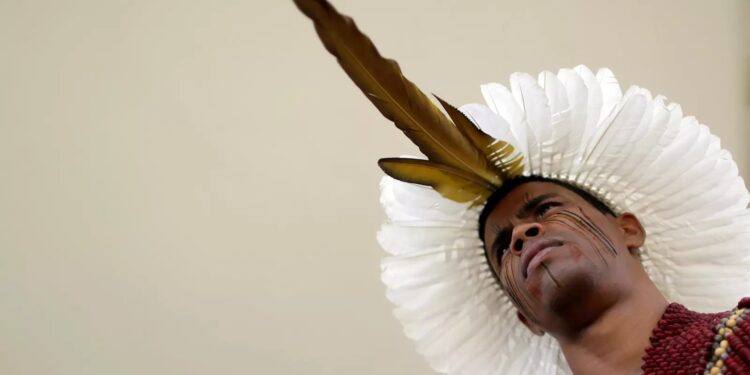5 ways Indigenous people are protecting the planet
This year focuses on the rights of Indigenous peoples to live in isolation from the rest of the world and how they are vulnerable to incursions on their lands as well as to communicable diseases.
- Advertisement -
A quarter of the Earth’s surface is in the care of Indigenous peoples – and it’s in better environmental shape than most of the rest of the world. So what can we learn from Indigenous people about how to care for our world?
August 9 is the United Nations’ (UN) International Day of the World’s Indigenous Peoples, a chance to reflect on the lives and contributions of the estimated 476 million Indigenous people who live across 90 countries.
- Advertisement -
This year focuses on the rights of Indigenous peoples to live in isolation from the rest of the world and how they are vulnerable to incursions on their lands as well as to communicable diseases.
- Advertisement -
Although they make up 5% of the global population, Indigenous people protect 80% of Earth’s remaining biodiversity. Their critical role is highlighted in the World Economic Forum’s 2023 report Embedding Indigenous Knowledge in the Conservation and Restoration of Landscapes. The Forum has also convened a community of global Indigenous leaders to help find solutions to the climate crisis, reverse biodiversity loss and foster a more sustainable relationship with our planet.
“These aren’t just people who happen to live in the Amazon,” said Cameron Saul, CEO and Creative Director of Bottletop and #TOGETHERBAND, at the Forum’s Annual Meeting in Davos earlier this year. “They’re one and the same. And it’s their innate relationship of reciprocity with the rainforest that enables it to flourish and that enables it to survive.”
Here are some of the ways Indigenous people are protecting the planet.
1. Safeguarding knowledge
Indigenous people have unique insights into how to conserve and protect the environment, built up, as the Forum’s report pointed out, over literally thousands of years and deeply embedded in their cultures.
The very survival of Indigenous communities in often challenging environments is proof of the value of their knowledge when it comes to helping the rest of the globe cope with the climate crisis, experts say.
The UN’s International Fund for Agricultural Development (IFAD) puts it like this: “Indigenous peoples have unique food systems anchored in sustainable livelihood practices, which are adapted to the specific ecosystems of their territories.” IFAD also says that Indigenous women are “full of untapped potential as stewards of natural resources and biodiversity”.
2. Food for all
Indigenous people are experts at small-scale community food production and the International Institute for Environment and Development says the rest of the world could learn a lot from their approach in a world where globalized food systems have come under increasing threat.
“The food systems of the world’s Indigenous peoples are highly productive, sustainable and equitable. These systems preserve rich biodiversity, provide nutritious food and are climate resilient and low carbon.”
The success of Indigenous people in producing healthy food while protecting their natural environments benefits the whole world, says the Forum’s report, which adds: “maintaining biodiversity is critical to ensuring a sustainable food supply, as well as providing protection from pollution, flooding and climate breakdown”.
Yet small-scale farmers are particularly vulnerable to the effects of the climate crisis. To address this, IFAD has invested in the Slow Food initiative that helps smallholders increase output and market their produce to a wider audience.
3. Enhancing biodiversity
Indigenous people take care of 80% of the world’s biodiversity.
- Advertisement -
Nearly half of the world’s endangered mammals live on land owned and protected by Indigenous people. In many countries, the richness of animal and plant life found on Indigenous people’s land is comparable to protected nature reserves, the Forum report says.
They also play a key role in protecting the Earth’s forests. Rates of deforestation in areas inhabited by Indigenous people are up to a quarter lower than the global average, reports Earth.org. As a result, Indigenous lands also have a higher preserved biodiversity than non-Indigenous lands.
With this in mind, scientists have created the Global Safety Net a blueprint to restore the world’s forests and biodiversity in order to rebalance Earth’s natural systems.
“We found that addressing Indigenous land claims, upholding existing land tenure rights and resourcing programmes on Indigenous-managed lands could help achieve biodiversity objectives on as much as one-third of the area required by the Global Safety Net,” a scientist from the team told The Guardian.
4. Custodians of the land
With around 20% of the world’s land managed by Indigenous peoples, their stewardship benefits not only their communities but all of us.
Speaking at Davos 2023, Fawn Sharp, President of the National Congress of American Indians, said that “we have no margin of error” when it comes to tackling the climate crisis and that “the most significant thing that people can learn from Native Americans is our spiritual connection to our lands, our spiritual connection to our creator”.
Indigenous people are custodians of their landscapes.Image: Unsplash/Kiyoshi
Indigenous people are on the frontline against illegal exploitation of the lands they occupy, even where government protections are in place. The World Resources Institute says that in the Amazon rainforest, patrols by Indigenous people have successfully stopped illegal logging.
In Suriname, Indigenous people took the initiative to declare 7.2 million hectares of rainforest as the South Suriname Conservation Corridor, acting as rangers to ensure its protection. The government subsequently gave the Corridor official status.
5. Taking climate action
Just by pursuing their traditional methods of cultivation, Indigenous people are acting to reduce carbon emissions which cause climate change. The Forum’s Embedding Indigenous Knowledge report said the re-introduction of traditional controlled forest burning by indigenous peoples of Northern Australia had halved the volume of carbon-emitting wildfires.
In February 2023, Indigenous people from all over the world met at the Indigenous Peoples’ Forum to discuss ways to spread their knowledge about how to promote sustainable ways of living and farming.
Warning that Indigenous people are particularly affected by the impacts of climate change, they called on governments to ensure that they include Indigenous people in discussions and decision-making about measures to tackle the climate emergency.
“I think the question that we need to be asking ourselves is, how can we make sure that it’s not a privilege, but ensure that it’s a right that we have to be in nature?” said Helena Gualinga, Co-Founder, Indigenous Youth Collective of Amazon Defenders, Ecuador, at Davos 2023. “And how can we make sure that we can restore these places that have been degraded elsewhere in the world so that we all can have access to nature?”
Source:norvanreports.com
- Advertisement -


